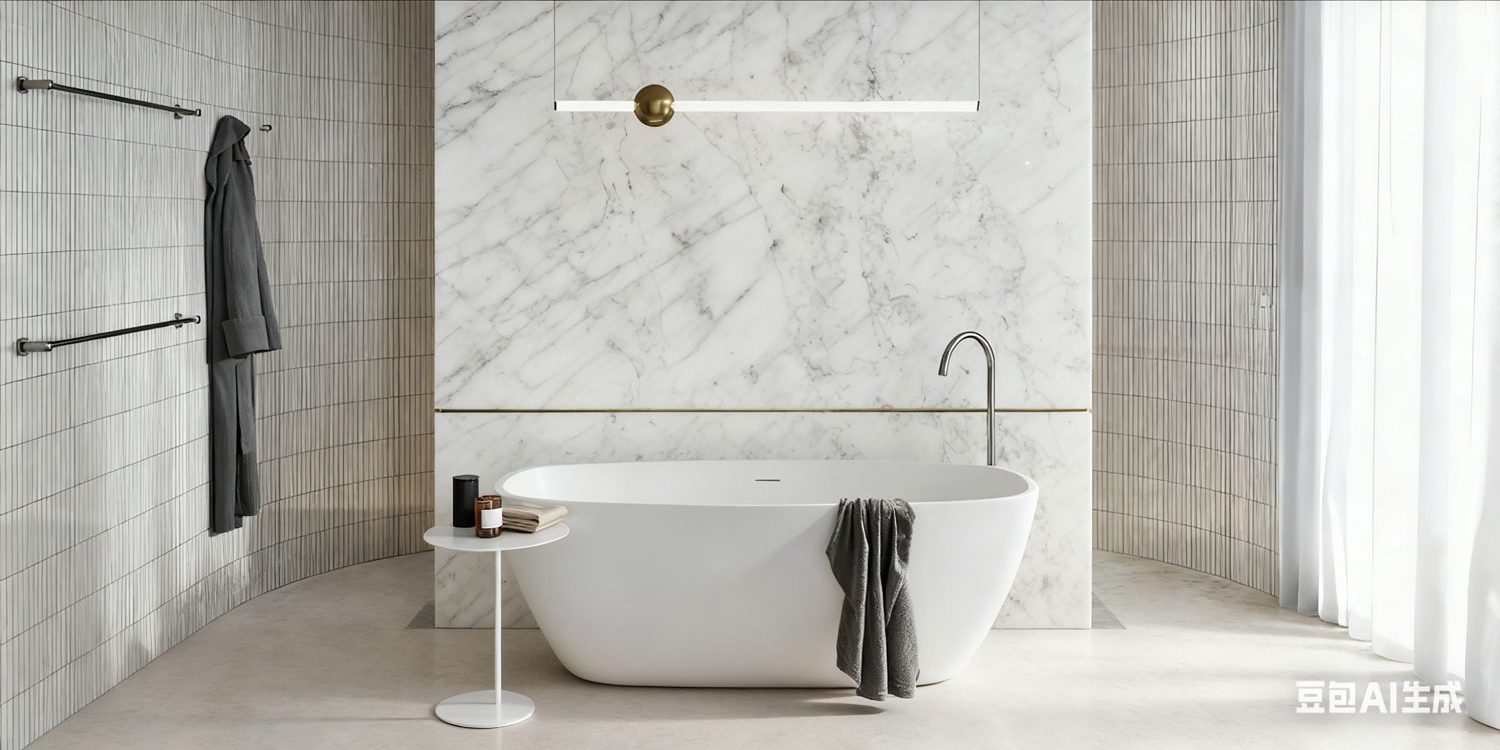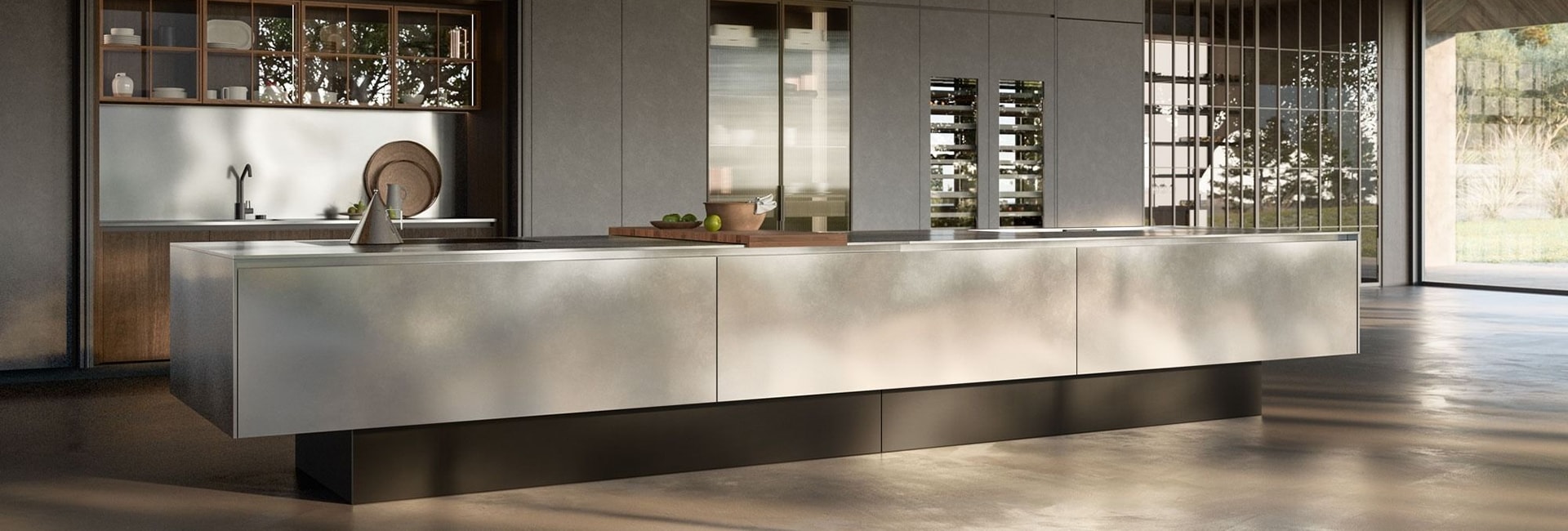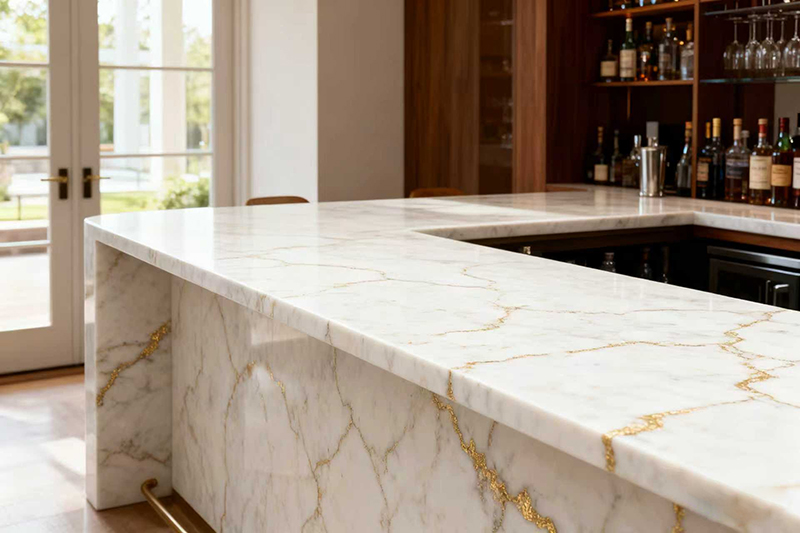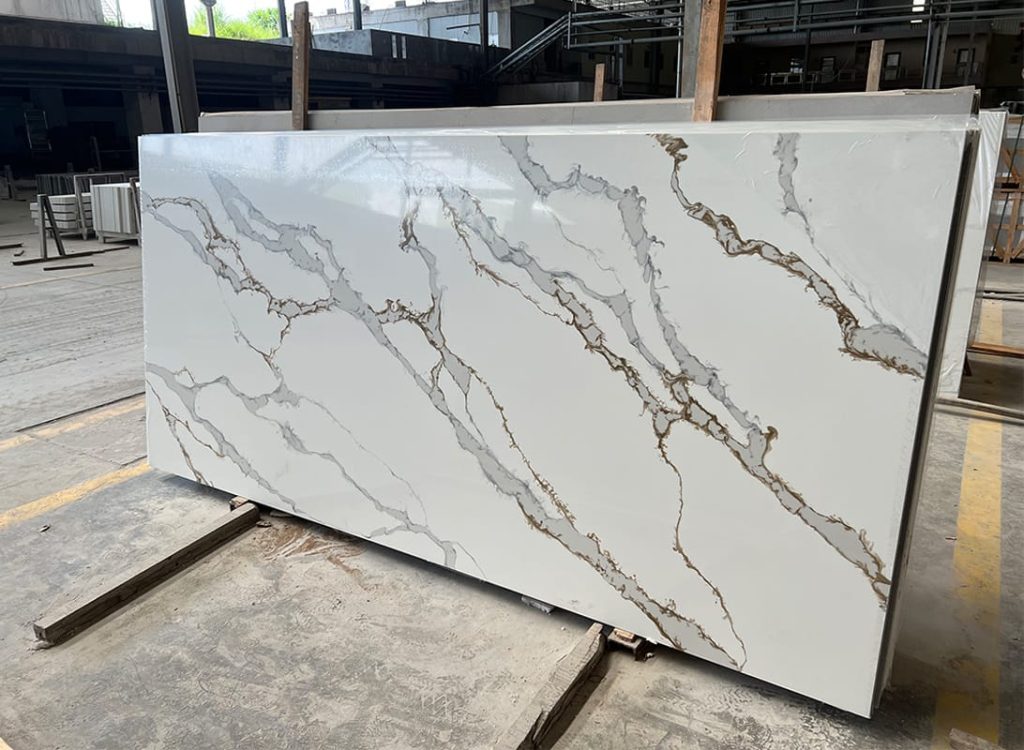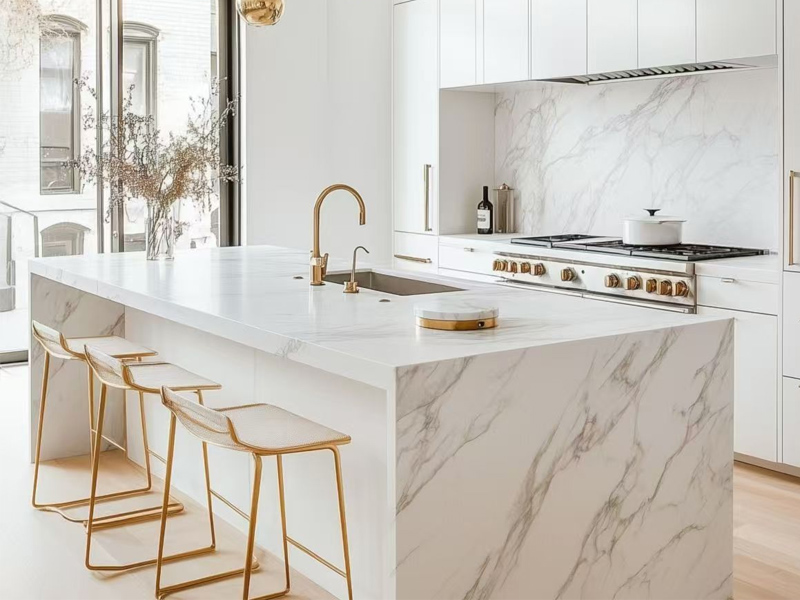
Calacatta Quartz Countertops
Variety and Sophistication by G-Stone
Calacatta Quartz Countertops refer to the premium countertops made by G-Stone quartz slabs with veins and textures resembling the natural calacatta marble stone from Italy. It requires no sealing, polishing, or reconditioning and is resistant to stains and scratches.
We are currently manufacturing and selling more than 100 different Calacatta Quartz designs for countertops accumulated over the past 15 years. Made from 93% above pure quartz, natural pigments, and other binders, this fusion of elements delivers elegant countertops that look natural and elegant, while offering greater resilience and function. And calacatta is the most used luxury artificial stone over the past decades for countertops,which occupy more than half of our production and delivery amounting to 50 thousands sets per year in different shaps and designings.
WHAT CALACATTA QUARTZ COUNTERTOPS DO WE HAVE
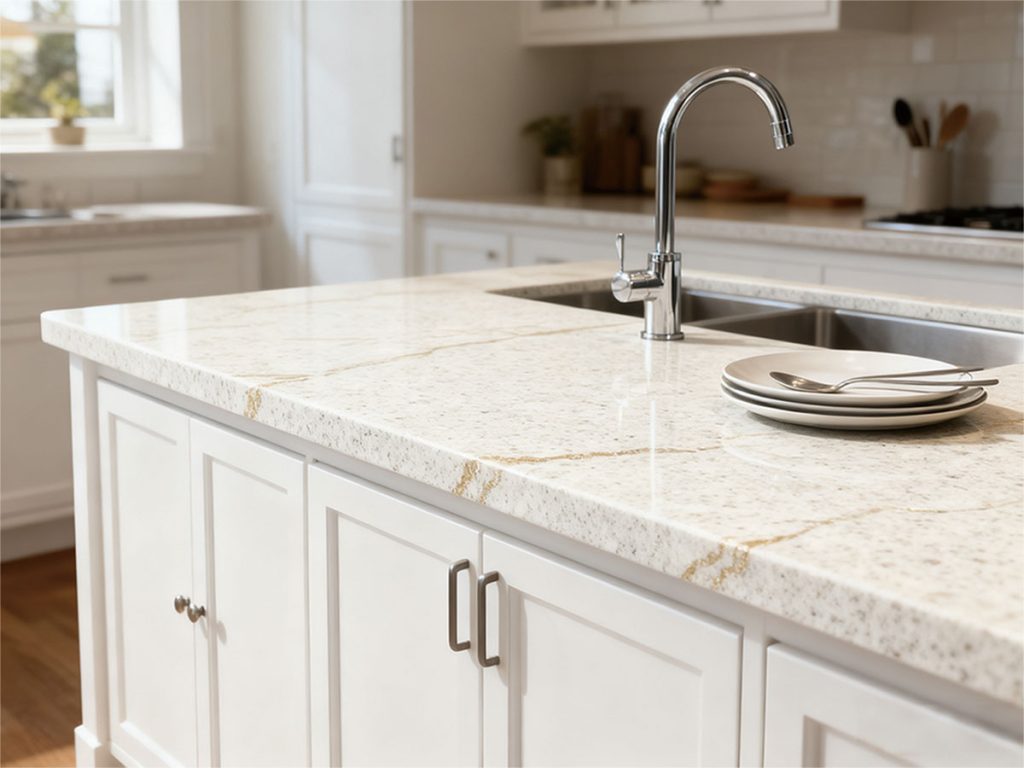
Kitchen Calacatta Quartz Countertops
Specify project-grade Calacatta quartz countertops for high-traffic kitchens. Our slabs offer superior durability and consistent veining for large-scale residential and commercial projects. Request technical specs.
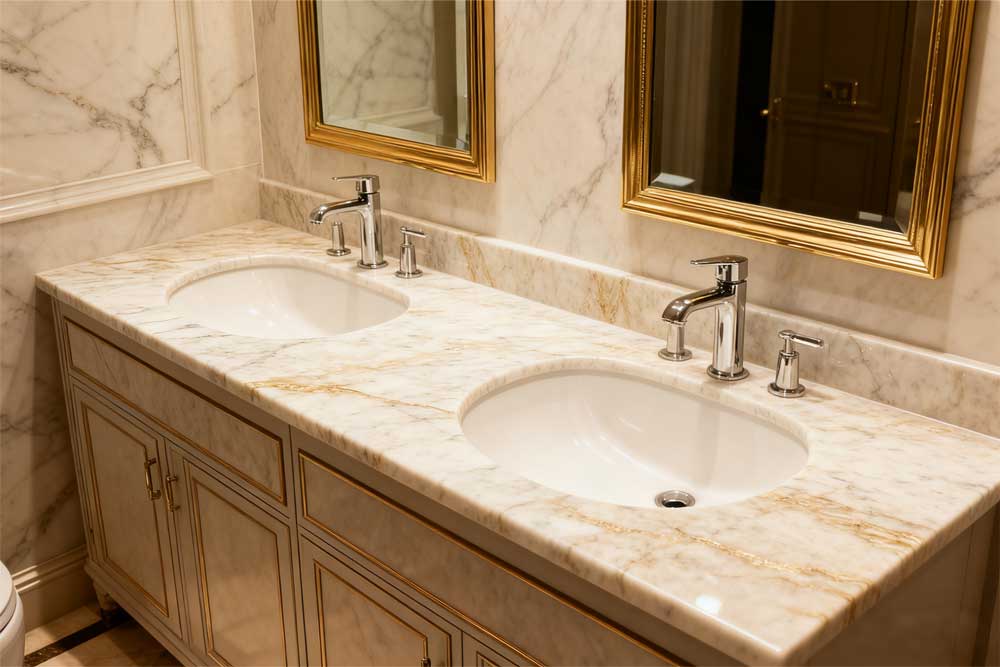
Bathroom Vanity Calacatta Quartz Countertops
Source hygienic and non-porous Calacatta quartz countertops for multi-unit bathroom vanities. Ideal for hotel and apartment projects, ensuring low maintenance and timeless appeal. Ask about volume pricing.

Commercial Calacatta Quartz Countertops
Equip high-traffic commercial spaces like hotels and restaurants with durable Calacatta quartz countertops. Engineered for longevity and backed by reliable supply chain. Download commercial catalog.

Jumbo Slab Calacatta Quartz Countertops
Minimize seams on expansive projects with our jumbo slab Calacatta quartz countertops. Achieve a seamless aesthetic for large islands and reception desks. Inquire about slab availability.

Custom Calacatta Quartz Countertops
We specialize in precision up to 0.5mm fabrication of Calacatta quartz countertops. From complex edges to custom cut-outs, we ensure a perfect fit for your unique design. Submit your project details.

Calacatta Quartz Countertops Projects
Explore our global portfolio of installed Calacatta quartz countertops. See how we deliver for international contractors and developers on luxury projects. View case studies.
NEWS ABOUT CALACATTA QUARTZ STONE
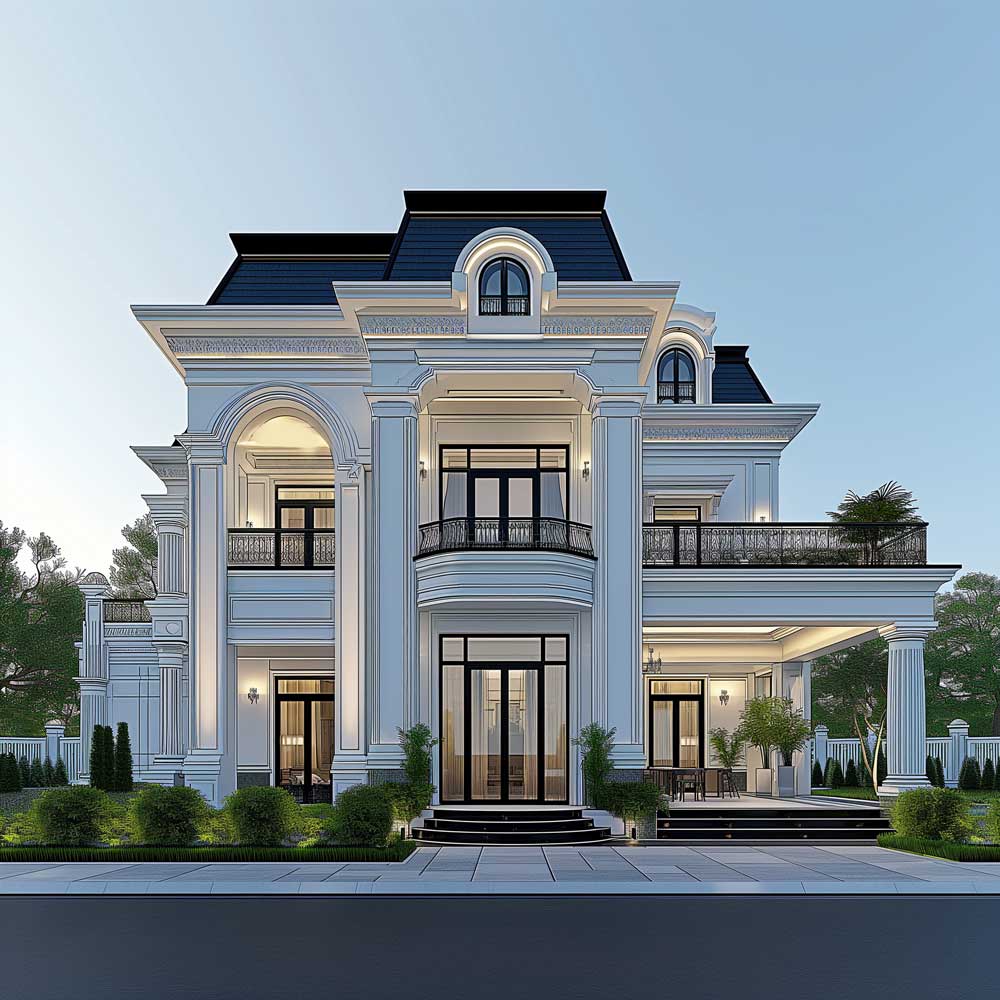
Real money talks, and when it comes to luxury interior design in Malaysia’s high-end villas and hotels, the choice of materials must balance aesthetics, durability, and cost-effectiveness. While natural stones like marble slab and granite have traditionally been popular, quartz stone slab has emerged as the superior choice for discerning property developers and designers. The fundamental advantage lies in quartz’s exceptional value proposition: it offers the luxurious appearance of high-end natural stone at a more accessible price point, while outperforming other materials in durability and maintenance requirements. Natural stones often prove impractical for Malaysia’s climate and high-traffic environments due to their porosity, susceptibility to staining, and demanding maintenance needs. Meanwhile, alternative materials simply cannot replicate the premium feel and sophistication that quartz delivers. This perfect balance of luxury aesthetics and practical benefits makes quartz stone the ideal solution for Malaysia’s luxury hospitality sector.
Introduction: The Rise of Quartz Stone in Malaysian Luxury Interiors
Malaysia’s hospitality and luxury real estate sectors have seen remarkable growth over the past decade. With an influx of tourists and a booming economy, properties like the St. Regis Kuala Lumpur and the Four Seasons Hotel Langkawi have set new standards in opulence and design. A key element in these transformations has been the strategic use of quartz stone in interiors. But why exactly is quartz stone becoming the go-to material for high-end villas and hotels in Malaysia? This blog delves into the reasons, backed by industry insights and case studies from Malaysia’s most prestigious properties.
1. Exceptional Durability and Strength for High-Traffic Areas
Quartz stone is renowned for its incredible durability, making it ideal for luxury villas and hotels that experience high foot traffic. Composed of approximately 90-95% natural quartz crystals and 5-10% polymer resins, quartz surfaces are non-porous, scratch-resistant, and highly resilient. In Malaysian hotels like The Ritz-Carlton, Kuala Lumpur, quartz countertops are used in kitchens, bathrooms, and common areas because they can withstand daily wear and tear without losing their luster. This durability translates to long-term cost savings, as replacements and repairs are minimized—a crucial factor for luxury properties aiming to maintain pristine conditions.
Moreover, quartz’s hardness (rated 7 on the Mohs scale) surpasses many natural stones, ensuring it remains intact even in bustling hotel lobbies or villa entrances. For instance, the St. Regis Kuala Lumpur incorporates quartz vanities in guest bathrooms, where durability is essential to handle frequent use by guests. This strength also makes quartz resistant to chipping and cracking, which is particularly valuable in Malaysia’s humid climate where temperature fluctuations can affect material integrity.
2. Aesthetic Versatility That Complements Luxury Design
One of the standout features of quartz stone is its aesthetic flexibility. Available in a wide range of colors, patterns, and finishes, quartz can mimic the look of natural stones like marble, granite, or onyx while offering superior performance. This versatility allows designers in Malaysia to create bespoke interiors that exude elegance and sophistication. For example, the Four Seasons Hotel Kuala Lumpur uses quartz surfaces in its suites and dining areas to achieve a seamless, modern look that appeals to discerning travelers. The ability to customize quartz—whether through veined patterns reminiscent of Carrara marble or solid hues for a minimalist vibe—makes it a favorite for luxury villas in destinations like Langkawi and Penang, where unique design statements are paramount.
In addition, quartz’s consistency in color and pattern ensures uniformity across large spaces, which is essential for hotels aiming for a cohesive aesthetic. This is evident in properties like the Mandarin Oriental, Kuala Lumpur, where quartz accents in lobbies and rooms create a harmonious flow. For villa owners, this means the material can be used throughout the property—from kitchen countertops to bathroom walls—without worrying about mismatched slabs.
3. Hygiene and Safety: A Non-Porous Surface for Cleanliness
In the post-pandemic era, hygiene has become a top priority for luxury accommodations. Quartz stone’s non-porous nature makes it inherently resistant to bacteria, mold, and stains, as it doesn’t absorb liquids or harbor germs. This is especially important in Malaysia’s tropical climate, where high humidity can promote microbial growth. Hotels like the Shangri-La Hotel Kuala Lumpur leverage quartz in bathrooms and kitchenettes to ensure a sanitary environment for guests. The ease of cleaning—requiring only mild soap and water—further enhances its appeal, reducing the need for harsh chemicals that could damage other surfaces.
Furthermore, quartz is certified by organizations like NSF International for food safety, making it suitable for kitchen countertops in luxury villas where gourmet cooking is common. This hygienic advantage not only protects guests but also aligns with the five-star standards that Malaysian hotels strive to uphold. For instance, the Banyan Tree Langkawi uses quartz in its villa kitchens to combine luxury with peace of mind, ensuring that every surface meets the highest health standards.
4. Low Maintenance and Ease of Care
Luxury properties in Malaysia demand materials that are both beautiful and practical, and quartz stone excels in low maintenance. Unlike natural stones such as marble or granite, quartz doesn’t require periodic sealing or special treatments to maintain its appearance. This is a significant advantage for busy hotels and villas, where time-efficient upkeep is essential. The St. Regis Kuala Lumpur, for example, uses quartz tabletops in its dining areas because they can be quickly wiped clean after each use, allowing staff to focus on other tasks.
Additionally, quartz’s resistance to stains from common substances like coffee, wine, or oils means that spills can be easily addressed without leaving permanent marks. This is crucial in villa settings, where homeowners entertain guests and host events. By choosing quartz, property managers in Malaysia reduce long-term maintenance costs while ensuring that interiors always look impeccable—a key selling point for luxury rentals and hotels competing in a crowded market.
5. Heat and Moisture Resistance for Malaysia's Climate
Malaysia’s hot and humid climate poses challenges for interior materials, but quartz stone is uniquely equipped to handle these conditions. Its composition makes it highly resistant to moisture, preventing warping or discoloration that can occur with wood or other surfaces. This is why hotels like the Majestic Hotel Kuala Lumpur incorporate quartz in bathrooms and outdoor-themed areas, where exposure to humidity is constant. Similarly, luxury villas in coastal regions such as Langkawi use quartz for outdoor kitchens and poolside bars, as it withstands sea air and rain without deteriorating.
Quartz also offers moderate heat resistance, though it’s advisable to use trivets for very hot items. This balance makes it suitable for Malaysian properties where indoor-outdoor living is popular. For example, the Datai Langkawi features quartz surfaces in its villas’ al fresco dining areas, blending durability with the natural beauty of the surroundings. By leveraging quartz’s climate adaptability, Malaysian luxury properties enhance both functionality and aesthetic appeal.
6. Cost-Effectiveness and Long-Term Value
While quartz stone may have a higher initial cost compared to some materials, its long-term value makes it a smart investment for luxury villas and hotels. The durability and low maintenance translate to reduced lifecycle costs, as quartz surfaces can last for decades with minimal care. In competitive markets like Malaysia’s hospitality industry, this cost-effectiveness allows properties to allocate resources to other amenities. The Four Seasons Resort Langkawi, for instance, uses quartz in its villas to achieve a luxury feel without exorbitant upkeep expenses, ultimately boosting profitability.
Moreover, quartz adds to the property’s resale or rental value by appealing to buyers and guests who prioritize quality and modern design. For villa developers in Malaysia, incorporating quartz into interiors can be a key differentiator in marketing materials, as seen in high-end projects like The RuMa Hotel and Residences in Kuala Lumpur. By choosing quartz, owners ensure that their investments remain attractive and functional for years to come.
7. Eco-Friendliness and Sustainability
As sustainability becomes a core concern in luxury design, quartz stone stands out for its eco-friendly attributes. Many quartz products use recycled materials and are manufactured with energy-efficient processes, reducing their environmental footprint. Brands like Caesarstone and Silestone, which are popular in Malaysia, adhere to green certifications, making them a responsible choice for properties aiming for LEED or other sustainability standards. Hotels like the EQ Kuala Lumpur have embraced quartz in their eco-conscious renovations, aligning with global trends toward green building.
In addition, quartz’s longevity means less frequent replacements, which minimizes waste. For luxury villas in Malaysia, this sustainability aspect can be a selling point for environmentally aware clients. By integrating quartz into their designs, properties contribute to a circular economy while maintaining a luxurious image—a win-win for both business and the planet.
Case Studies: Quartz Stone in Malaysian Luxury Properties
To illustrate these benefits, let’s examine how specific Malaysian hotels and villas have successfully incorporated quartz stone into their interiors:
- The St. Regis Kuala Lumpur: This five-star hotel uses quartz countertops in its guest suites and spa areas for their durability and elegant appearance. The material’s ability to resist stains and moisture has made it ideal for high-use spaces, enhancing the guest experience while reducing maintenance costs.
- Four Seasons Hotel Langkawi: In its luxury villas, quartz is featured in kitchens and bathrooms, where its non-porous surface ensures hygiene and its aesthetic versatility complements the resort’s natural surroundings. This has helped the property maintain its reputation for sophistication and comfort.
- The Ritz-Carlton, Kuala Lumpur: Known for its opulent design, this hotel utilizes quartz in lobby accents and restaurant tabletops. The stone’s heat and scratch resistance have proven invaluable in busy dining environments, while its sleek look adds to the overall luxury ambiance.
- Banyan Tree Langkawi: This resort incorporates quartz in its villa interiors to blend durability with tropical elegance. The material’s resistance to humidity has been particularly beneficial in Langkawi’s coastal climate, ensuring long-lasting beauty.
These examples demonstrate how quartz stone can elevate the design and functionality of luxury properties in Malaysia, making it a worthwhile investment for developers and owners alike.
Conclusion: Embrace Quartz Stone for Your Malaysian Luxury Property
In summary, quartz stone offers a compelling combination of durability, aesthetics, hygiene, low maintenance, climate resistance, cost-effectiveness, and sustainability that makes it ideal for luxury villas and hotels in Malaysia. As evidenced by leading properties like the St. Regis and Four Seasons, quartz can transform interiors into spaces that are both beautiful and practical. Whether you’re developing a new villa or renovating an existing hotel, consider integrating quartz stone to enhance your property’s appeal and value.
If you’re inspired to incorporate quartz stone into your project, visit www.china-countertop.com to explore our premium quartz products. Our team can help you select the perfect options for your needs, ensuring that your Malaysian property stands out in the competitive luxury market. Contact us today for a consultation!

Many ask: “Is custom stone a practical choice, or just a luxury for the elite?“
Walk into any stone supplier’s showroom, and you’ll see the same familiar quartz and granite slabs. They’re beautiful, but generic. What happens when your vision is constrained by their catalog, or your project demands something truly unique?
The truth is, for forward-thinking designers, builders, and retailers, custom quartz stone slabs are a strategic business decision, not an extravagance. It’s the key to solving real-world design, sourcing, and commercial challenges.
Here’s how deep customization is reshaping the industry, far beyond simple color choices.

1. The Art of Replication: Capture Any Look, Perfect It.
Imagine a client shows you a sample of a rare, extinct marble from a historic building. Or they love a pattern from a high-end brand, but it’s patented or out of stock.
This is where we excel.
We specialize in taking your sample—be it natural stone or an existing quartz slab—and replicating it with over 90% accuracy. But we don’t just copy; we optimize. We can strengthen weak veins, enhance color consistency, and create a more durable, harmonious version of the original.
Project Spotlight: The "Nova Hotel" Chain in China
Challenge: The Nova Hotel Group wanted a specific, veined Calacatta marble look for their bathroom vanities across 10 locations. The natural stone was too porous for high-traffic use, and the branded quartz they liked was patented.
Our Solution: We created a custom quartz stone that captured the exact veining and warmth of their reference sample. We even adjusted the pattern scale for a more dramatic effect on larger vanities. The result was a consistent, exclusive, and highly durable material that met their aesthetic and functional needs perfectly, all while navigating around patent restrictions.
2. Freedom from Standard Sizes: Your Vision, Uncompromised.
Why force your design to fit standard slab dimensions? Whether it’s an extra-long kitchen island, a seamless commercial reception desk, or a towering fireplace surround, physical constraints should not limit your creativity.
We provide complete physical dimension customization. Specify the exact length, width, and thickness you need. This eliminates unsightly seams, reduces material waste, and enables truly monolithic, breathtaking designs.
3. From Slab to Product: The Ultimate Customization.
The true power of custom stone is realized when you shape it into the final application. We don’t just supply the raw material; we help fabricate it into the centerpiece of your space.
- Custom Countertops: With unique edge profiles, integrated drainboards, or precisely cut openings.
- Custom Vessel Sinks: Create a stunning, one-of-a-kind custom vessel sink that becomes the bathroom’s focal point.
- Integrated Shower Systems: Fully custom-sized shower walls and basins for a flawless, minimalist wet room.
Project Spotlight: "Aura" Boutique in Thailand
Challenge: This high-end retailer needed a unique, sculptural custom vessel sink for their flagship store’s restroom—something no customer had ever seen before.
Our Solution: We worked with their designer to fabricate a freestanding sink from a single, flowing custom quartz stone slab. The organic shape and continuous, seamless surface became a talking point and perfectly embodied the store’s brand identity of exclusive luxury.
Why Your Business Needs Custom Stone
Choosing custom quartz stone isn’t just about aesthetics; it’s a smart business move:
- Navigate Patents: Create beautiful alternatives to patented designs from big brands.
- Product Exclusivity: Build your brand around products that can’t be found anywhere else.
- Perfect Project Fit: Ensure the material is technically and dimensionally perfect for the job, saving time and money on-site.
So, is it crazy to go custom? Only if you’re satisfied with the ordinary.
If your goal is to stand out, solve complex problems, and deliver unparalleled value to your clients, then custom stone slabs are your most powerful tool.
Ready to stop compromising and start creating?
Keywords & Expertise
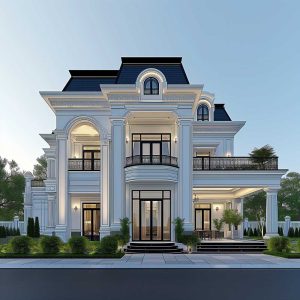
Why Luxury Villas and Hotels in Malaysia Are Embracing Quartz Stone in Interior Design
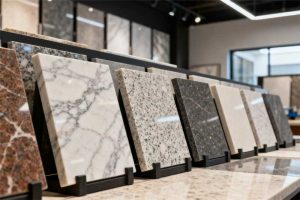
Beyond the Showroom: Why Custom Stone Slabs Are Your Secret Weapon
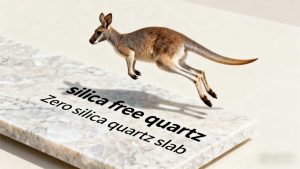
The Truth About Zero Silica Quartz: A Scientific Perspective
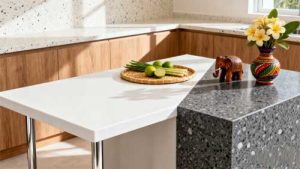
Southeast Asia’s Growing Preference for Quartz Countertops

Are Countertop Makers Shifting from Quartz to Sintered Stone?
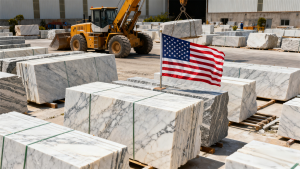
Trade War Impact on Chinese Stone Exports in 2025

Important Clarification: When manufacturers refer to “silica-free quartz” or use terms like “zero silica quartz” in marketing materials, they’re not claiming the complete absence of silicon dioxide. Instead, they’re referring to products formulated to eliminate or significantly reduce crystalline silica, which poses health risks when inhaled as dust during fabrication.

Australian Context
For Australian homeowners, builders, and architects seeking premium countertop materials, understanding the composition of quartz surfaces is crucial for making informed decisions that meet both aesthetic preferences and safety standards.
In the world of engineered stone surfaces, particularly in the quartz countertop industry, there’s a common misconception that needs addressing: the idea of “zero silica quartz.” As a technical marketing expert at G-STONE, a leading manufacturer of premium quartz surfaces, I frequently encounter this misunderstanding among both industry professionals and consumers.
Key Insight: Zero silica quartz does not exist in reality, but silica-free quartz does exist as a commercial product category with a specific meaning that differs from what many assume.
This blog post will explore the scientific and technical aspects of quartz composition, clarify the terminology confusion, and help you understand what “silica-free quartz” truly means in the context of engineered stone surfaces.
The Common Misconception
Many consumers and even some industry professionals mistakenly believe that “silica-free quartz” or “zero silica quartz” refers to a product that contains absolutely no silicon dioxide (SiO₂) – the chemical compound commonly known as silica. This misunderstanding can lead to incorrect assumptions about product safety, durability, and composition.
Important Clarification: When manufacturers refer to “silica-free quartz” or use terms like “zero silica quartz” in marketing materials, they’re not claiming the complete absence of silicon dioxide. Instead, they’re referring to products formulated to eliminate or significantly reduce crystalline silica, which poses health risks when inhaled as dust during fabrication.
This distinction is crucial for several reasons:
- It affects how we understand product safety during installation and fabrication
- It influences material selection for specific applications
- It impacts regulatory compliance in various markets, including Australia
- It determines appropriate handling procedures for fabricators
In the Australian market, where workplace health and safety standards are particularly stringent, understanding this distinction becomes even more important. The confusion between “zero silica” and “silica-free” terminology can lead to misinformed purchasing decisions and potentially unsafe handling practices.
Throughout this comprehensive guide, we’ll explore the chemistry behind quartz surfaces, the manufacturing processes that create “silica-free” alternatives, and what these terms truly mean for you as a consumer, designer, or fabricator.
The Science Behind Quartz Composition
To understand why “zero silica quartz” is a scientific impossibility, we need to explore the fundamental composition of quartz surfaces and the chemistry that makes them such durable and attractive materials for countertops and other applications.
What is Quartz, Chemically Speaking?
At its most basic level, quartz is a crystalline form of silicon dioxide (SiO₂). This mineral is one of the most abundant on Earth and forms the primary component of many natural stones, including granite and sandstone.
Silicon Dioxide (SiO₂)
Silicon dioxide, commonly known as silica, is a chemical compound consisting of one silicon atom bonded to two oxygen atoms. It appears naturally in several crystalline forms, with quartz being the most common and stable at room temperature.
Engineered quartz surfaces, such as those manufactured by G-STONE, typically contain:
- 90-95% natural quartz crystals – providing durability and the characteristic sparkle
- 5-10% polymer resins – binding the quartz particles together
- Pigments and additives – for color and special properties
Given this composition, it’s chemically impossible to create a “zero silica quartz” product while still maintaining the essential characteristics that define quartz surfaces. The very name “quartz” implies the presence of silicon dioxide.
The Health Concern: Crystalline Silica
The health concerns associated with quartz surfaces don’t stem from the material in its finished form, but from the dust generated during cutting, grinding, and polishing. When inhaled, fine particles of crystalline silica can pose serious respiratory health risks.
Australian Regulations
In Australia, Safe Work Australia has established strict workplace exposure standards for crystalline silica. The current workplace exposure standard for respirable crystalline silica is 0.05 mg/m³ averaged over an 8-hour workday.
This health concern has driven innovation in the industry, leading to the development of what are marketed as “silica-free quartz” or “zero silica quartz” products. However, these terms can be misleading without proper context.
What “Silica-Free Quartz” Really Means
When manufacturers refer to “silica-free quartz” or use similar terminology, they’re typically describing products where:
| Traditional Quartz | So-Called “Silica-Free Quartz” |
|---|---|
| Contains 90-95% crystalline silica | Replaces crystalline silica with alternative materials |
| Generates respirable crystalline silica dust when cut | Produces minimal or no respirable crystalline silica dust |
| Requires strict dust control measures during fabrication | May have reduced dust control requirements |
| Composition based primarily on natural quartz | Composition based on alternative minerals or manufactured materials |
These alternative materials might include:
- Recycled glass
- Porcelain and ceramic materials
- Other natural minerals with low silica content
- Advanced composite materials
Technical Note: Some “silica-free” products may still contain amorphous silica (non-crystalline forms) or small amounts of crystalline silica, but at levels low enough to meet regulatory thresholds for “silica-free” classification in certain markets.
The key distinction is that while these products dramatically reduce or eliminate the health risks associated with crystalline silica dust, they may not be completely free of silicon dioxide in all its forms.

The Manufacturing Process Difference
Traditional quartz manufacturing involves mixing natural quartz crystals with resins and pigments, then compressing and heating the mixture to form solid slabs. The high quartz content is what gives these surfaces their exceptional hardness and durability.
In contrast, “silica-free” alternatives use different base materials that provide similar physical properties without the high crystalline silica content. The manufacturing process may be similar, but the raw materials differ significantly.
At G-STONE, we’re transparent about the composition of all our products, including our range of lower-silica alternatives that meet the growing demand for safer fabrication options while maintaining the aesthetic and functional qualities that make quartz surfaces so popular.
Navigating the Market: A Guide for Consumers and Professionals
Understanding the distinction between marketing terminology and scientific reality is essential for making informed decisions in the quartz surface market. This final section provides practical guidance for consumers, designers, and fabricators navigating this complex landscape.
Why Terminology Matters
The confusion between “zero silica quartz” and “silica-free quartz” isn’t just semantic—it has real-world implications for:
- Health and safety compliance – particularly in regulated markets like Australia
- Product performance expectations – different compositions have different characteristics
- Installation and fabrication requirements – proper handling depends on accurate material knowledge
- Long-term durability and maintenance – material composition affects how surfaces age
Consumer Alert: Be wary of manufacturers or suppliers who claim their products contain “zero silica” while still marketing them as quartz surfaces. This is scientifically inaccurate and potentially misleading.
Questions to Ask Suppliers
When considering quartz surfaces or their alternatives, ask suppliers these key questions:
Essential Questions About Silica Content
- What is the exact crystalline silica content of this product?
- Has the product been tested by independent laboratories for respirable crystalline silica content?
- What safety data sheets (SDS) are available for this product?
- Does this product meet Australian standards for low-silica or silica-free classification?
- What alternative materials are used in place of crystalline silica?
- How do the physical properties compare to traditional quartz surfaces?
Reputable manufacturers like G-STONE will provide transparent, detailed information about product composition and safety data.
The Australian Market Context
In Australia, awareness of silicosis risks has grown significantly in recent years, leading to increased demand for safer alternatives to traditional quartz surfaces. Australian regulations now require strict dust control measures when working with materials containing crystalline silica.
For Australian consumers and professionals, this means:
- Increased scrutiny of material composition and safety data
- Growing preference for verified low-silica alternatives
- Higher expectations for manufacturer transparency
- Greater emphasis on proper fabrication practices regardless of material type
At G-STONE, we’ve responded to these market needs by developing products with reduced crystalline silica content while maintaining the aesthetic appeal and performance characteristics that make quartz surfaces so desirable.
Proper Handling of All Engineered Stone Products
Regardless of the silica content, proper safety measures should always be followed when fabricating any engineered stone product:
| Safety Measure | Importance |
|---|---|
| Water suppression systems | Reduces dust generation during cutting and grinding |
| Local exhaust ventilation | Captures dust at the source |
| Appropriate respiratory protection | Protects against inhalation of fine particles |
| Regular air monitoring | Ensures workplace exposure limits are not exceeded |
| Worker education and training | Ensures proper handling and awareness of risks |
Even with “silica-free” alternatives, these safety practices are recommended, as dust from any material can pose respiratory risks when inhaled in sufficient quantities.
Industry Best Practice: The most responsible approach is to treat all engineered stone products as potentially generating hazardous dust during fabrication, implementing appropriate controls regardless of the specific material composition.
The Future of Quartz and Alternative Surfaces
The engineered stone industry continues to evolve, with ongoing research into:
- New binding technologies that reduce or eliminate crystalline silica content
- Advanced composite materials with improved safety profiles
- More accurate and standardized testing methods for silica content
- Clearer industry terminology and classification systems
As these developments progress, transparency and accurate information will become even more critical for both manufacturers and consumers.
Distributors & Contractors in Australia
Conclusion
The distinction between “zero silica quartz” and “silica-free quartz” is more than just semantics—it’s about scientific accuracy, consumer transparency, and workplace safety. While truly “zero silica” quartz doesn’t exist, products with significantly reduced crystalline silica content are available and offer important safety benefits during fabrication.
As a consumer or professional in the Australian market, understanding this distinction empowers you to make informed decisions, ask the right questions, and implement appropriate safety measures regardless of the materials you choose.
At G-STONE, we’re committed to product innovation that doesn’t compromise on safety, quality, or transparency. We invite you to explore our range of quartz surfaces and alternative materials, all backed by detailed technical information and a commitment to excellence.
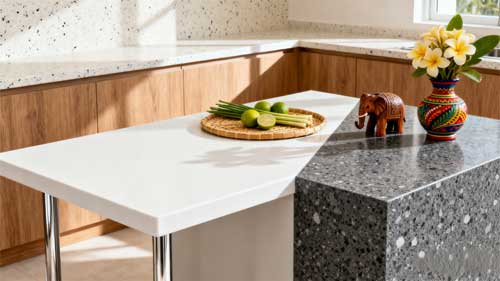
In recent years, Southeast Asian markets have demonstrated a remarkable and growing preference for quartz countertops, transforming the region into one of the fastest-growing markets for engineered stone surfaces. This trend is driven by a combination of rising disposable incomes, urbanization, and a growing appreciation for durable, low-maintenance, and aesthetically pleasing home surfaces. As the middle class expands across countries like Vietnam, Thailand, Indonesia, Malaysia, and the Philippines, the demand for premium kitchen and bathroom solutions has surged, with quartz emerging as the material of choice for both residential and commercial projects.
Factors Driving Quartz Popularity in Southeast Asian Markets
Several interconnected factors are contributing to the rising popularity of quartz countertops across Southeast Asia:
Rising Middle-Class Disposable Income
As economies in Vietnam, Indonesia, Thailand, and Malaysia continue to grow, an expanding middle class with higher disposable income is investing more in home improvement. Quartz countertops, once considered a luxury item, are now within reach for a broader segment of the population seeking to elevate their living spaces.
Urbanization and Apartment Living
Rapid urbanization across Southeast Asia has led to a boom in condominium and apartment construction. In these compact urban dwellings, quartz offers the perfect combination of style and functionality, with its seamless appearance and durability making it ideal for modern, space-efficient kitchens and bathrooms.
Climate Compatibility
Southeast Asia’s hot and humid climate creates unique challenges for building materials. Quartz’s non-porous surface resists moisture absorption, preventing mold and bacterial growth—a significant advantage over natural stone in tropical environments where humidity can exceed 80% year-round.
Western Design Influences
Exposure to international design trends through social media, television, and travel has influenced Southeast Asian homeowners to adopt Western-style open-plan kitchens, where quartz countertops serve as both functional surfaces and design centerpieces.
Country-Specific Quartz Market Analysis in Southeast Asia
The preference for quartz varies across Southeast Asian markets, with each country demonstrating unique trends and adoption patterns:
| Country | Market Characteristics | Popular Quartz Colors & Styles | Growth Rate (Annual) |
|---|---|---|---|
| Vietnam | Rapid urbanization, strong preference for marble-look quartz | White Carrara, Calacatta Gold, Statuario | 18-22% |
| Thailand | Mature market, luxury hospitality sector driving demand | Concrete looks, neutral tones, subtle patterns | 12-15% |
| Indonesia | Emerging premium segment, growing middle class | Warm tones, beige backgrounds, subtle veining | 20-25% |
| Malaysia | Well-established market, competitive pricing | Gray tones, abstract patterns, solid colors | 10-12% |
| Philippines | Rapid adoption in residential projects, OFW influence | Bright whites, bold veining, dramatic patterns | 15-18% |
These country-specific trends highlight the importance of understanding local preferences when marketing quartz products in Southeast Asia. While white marble-look quartz dominates in Vietnam and the Philippines, Thailand and Malaysia show stronger preferences for contemporary concrete looks and solid colors.
[IMAGE PLACEHOLDER: Insert photo showing quartz countertop installation in a Southeast Asian kitchen]
Design Preferences and Aesthetic Trends in Southeast Asia
Southeast Asian consumers have developed distinct preferences when it comes to quartz countertop aesthetics:
Marble-Look Quartz Dominance
The desire for luxury marble aesthetics without the maintenance challenges has made marble-look quartz the most popular category across Southeast Asia. White backgrounds with gray or gold veining, particularly styles mimicking Carrara, Calacatta, and Statuario marbles, account for over 60% of quartz sales in the region.
Color Preferences by Country
While white remains universally popular, regional color preferences are emerging. Vietnamese consumers favor bright whites with dramatic veining, while Indonesian buyers prefer warmer beige tones. Malaysian and Singaporean markets show stronger interest in gray tones and concrete-look quartz.
Finish Preferences
Polished finishes remain the most popular across Southeast Asia, favored for their reflective qualities that help brighten interior spaces. However, matte and suede finishes are gaining traction, particularly in commercial applications and among design-forward consumers seeking contemporary aesthetics.
Competitive Landscape: Quartz vs Traditional Materials
Quartz’s growth in Southeast Asia has come largely at the expense of traditional countertop materials:
Quartz vs Granite
While granite remains popular for its natural beauty, quartz is gaining market share due to its non-porous nature, consistency of pattern, and lower maintenance requirements—particularly important in humid climates where sealing natural stone can be challenging.
Quartz vs Solid Surface
Quartz offers superior heat and scratch resistance compared to solid surface materials like Corian, making it more suitable for Southeast Asian kitchens where cooking often involves high heat and extensive food preparation.
Quartz vs Porcelain Slabs
While large-format porcelain slabs are emerging as competitors, quartz maintains advantages in workability, edge detailing options, and a warmer, more natural feel that resonates with Southeast Asian consumers.
The competitive dynamics vary across the region, with quartz holding the strongest position in Vietnam and the Philippines, while facing stiffer competition from granite in Indonesia and Malaysia.
[IMAGE PLACEHOLDER: Insert photo comparing quartz with traditional materials in Southeast Asian context]
Distribution Channels and Market Entry Strategies
Understanding Southeast Asia’s diverse distribution landscape is crucial for quartz manufacturers seeking to enter or expand in these markets:
Key Distribution Channels
The quartz market in Southeast Asia is served through multiple channels, including direct sales to developers, partnerships with kitchen studios and interior designers, distribution through building material retailers, and increasingly, online platforms that cater to the DIY and renovation markets.
Market Entry Considerations
Successful market entry requires adapting to local business practices, establishing relationships with influential interior designers and architects, participating in regional trade shows, and developing marketing materials that resonate with local aesthetic preferences and practical needs.
Pricing Strategies
While premium positioning works well in markets like Singapore and Thailand, competitive pricing is essential in price-sensitive markets like Indonesia and the Philippines, where mid-range quartz products often perform best.
Future Outlook: Sustainability and Market Evolution
The future of quartz in Southeast Asia looks promising, with several trends shaping the market’s evolution:
Sustainability Concerns
As environmental awareness grows across Southeast Asia, manufacturers are responding with more sustainable quartz production methods, recycled content options, and transparency about material sourcing and manufacturing processes.
Thinner Slab Development
The development of thinner, lighter quartz slabs is making the material more suitable for vertical applications and renovation projects where weight considerations are important—particularly relevant in Southeast Asia’s high-rise urban environments.
Digital Integration
Augmented reality apps and digital visualization tools are becoming increasingly important in the region, allowing customers to preview quartz countertops in their spaces before making purchase decisions.
As Southeast Asian economies continue to develop and urbanize, the quartz market is expected to maintain strong growth, with premiumization and product innovation driving value even as market penetration increases.
Capture the Southeast Asian Quartz Market Opportunity
As Southeast Asia’s preference for quartz countertops continues to grow, positioning your business to serve this dynamic market is essential for long-term success. China Countertop offers a comprehensive range of quartz slabs specifically designed to meet the aesthetic preferences and performance requirements of Southeast Asian consumers.
Contact us today to discuss distribution opportunities, request market-specific product recommendations, or schedule a virtual showroom tour of our quartz collections.
Conclusion: Southeast Asia’s Quartz Revolution
Southeast Asia’s growing preference for quartz countertops represents a significant opportunity for manufacturers, distributors, and fabricators. Driven by urbanization, rising incomes, and practical considerations suited to the region’s climate, quartz has established itself as the premium surface material of choice for a new generation of Southeast Asian homeowners and developers.
The market’s evolution continues, with country-specific preferences emerging and new applications developing. Success in this diverse region requires understanding local nuances, building strong distribution partnerships, and offering products that balance aesthetic appeal with the practical demands of Southeast Asian living environments.
As the region’s economies continue their upward trajectory and middle-class expansion accelerates, the quartz revolution in Southeast Asia is positioned for continued growth, offering substantial opportunities for businesses that can effectively navigate this dynamic and promising market.
Article Keywords
quartz market Vietnam
engineered stone Thailand
quartz slabs Indonesia
marble look quartz
kitchen countertops Malaysia
Southeast Asia construction materials
quartz vs granite
premium surfaces Philippines
quartz distributor Southeast Asia
quartz trends 2024
urbanization countertop demand

The countertop industry is witnessing a significant transformation as manufacturers and fabricators explore new materials that offer enhanced performance and aesthetics. For years, quartz slabs have dominated the market as the premium choice for residential and commercial surfaces. However, a new contender—sintered stone—is gaining traction and prompting many to question whether we’re seeing a fundamental shift in material preference.As a leading manufacturer of both quartz and sintered stone slabs, we at China Countertop have observed this evolving trend firsthand. In this article, we’ll explore the reasons behind this potential shift, compare the properties of both materials, and discuss what this means for countertop fabricators and their clients.

Understanding the Materials: Quartz vs. Sintered Stone
Before analyzing the shift, it’s essential to understand what distinguishes these two popular materials:
Quartz Slabs
Quartz countertops are engineered stone products made from approximately 90-95% ground natural quartz blended with polymers, resins, and pigments. This composition creates a non-porous, durable surface that resists staining and requires minimal maintenance.
Sintered Stone Slabs
Sintered stone is created through a process of extreme heat and pressure that fuses natural minerals without using resins. This manufacturing technique results in an ultra-compact surface with exceptional durability, heat resistance, and UV stability, making it suitable for both indoor and outdoor applications.
Why Are Countertop Makers Considering the Shift?
Several factors are driving fabricators to explore sintered stone as an alternative to quartz:
1. Enhanced Durability and Performance
Sintered stone offers superior resistance to heat, UV rays, scratches, and stains compared to quartz. While quartz can be damaged by excessive heat (above 150°C/300°F), sintered stone can withstand much higher temperatures without damage, making it ideal for kitchen applications where hot pots and pans are frequently placed directly on the surface.
2. Greater Design Versatility
Sintered stone slabs often feature more realistic veining and patterns that closely mimic natural stone like marble and granite. Advanced digital printing technology allows for incredibly realistic reproductions of natural stone patterns without the maintenance challenges associated with natural materials.
3. Expanding Application Possibilities
Due to its UV resistance and weather durability, sintered stone can be used for both indoor and outdoor applications, including facades, patio countertops, and pool surrounds—applications where quartz would be unsuitable.
4. Health and Sustainability Considerations
Sintered stone contains no resins or VOCs (volatile organic compounds), making it a healthier choice for indoor environments. Additionally, its composition of natural minerals makes it fully recyclable, aligning with growing consumer demand for sustainable building materials.
Quartz vs. Sintered Stone: A Detailed Comparison
| Feature | Quartz Slabs | Sintered Stone Slabs |
|---|---|---|
| Composition | 90-95% quartz with resins | 100% natural minerals (no resins) |
| Heat Resistance | Moderate (up to 150°C/300°F) | Excellent (up to 400°C/750°F) |
| UV Resistance | Limited (may discolor over time) | Excellent (no fading) |
| Stain Resistance | Excellent | Excellent |
| Scratch Resistance | Very Good | Excellent |
| Applications | Indoor use only | Indoor & outdoor use |
| Installation | Standard fabrication techniques | Requires specialized tools |
| Cost | Premium | Premium to Ultra-Premium |
The Fabrication Perspective: Challenges and Opportunities
For countertop makers considering the transition to sintered stone, several factors need consideration:
Fabrication Requirements
Sintered stone’s extreme hardness requires specialized cutting and polishing equipment. Fabricators need to invest in diamond-tipped tools and water jets to work with this material effectively. While this represents an initial investment, it positions fabricators to serve a growing premium market segment.
Installation Considerations
Due to its weight and brittleness during handling, sintered stone requires careful installation. However, once installed, it offers exceptional long-term performance with minimal maintenance requirements.
Market Positioning
Offering sintered stone allows fabricators to target the high-end residential and commercial markets where clients seek the ultimate in performance and aesthetics. This diversification can help businesses differentiate themselves in a competitive marketplace.
Is This a Complete Shift or Market Diversification?
While sintered stone is gaining popularity, it’s important to note that quartz remains an excellent choice for many applications. Rather than a complete replacement, we’re seeing market diversification where:
- Quartz continues to dominate the mainstream premium countertop market
- Sintered stone captures the ultra-premium segment and specialized applications
- Fabricators increasingly offer both materials to serve different client needs
The choice between quartz and sintered stone ultimately depends on the specific requirements of each project, including budget, performance needs, and design preferences.
Explore Our Premium Quartz and Sintered Stone Collections
Whether you’re considering quartz, sintered stone, or both for your projects, China Countertop offers premium-quality slabs with consistent coloring and superior performance characteristics. Our extensive collection includes a wide range of colors, patterns, and finishes to suit any design vision.
Contact us today to request samples or discuss your specific project requirements.
Conclusion
The countertop industry is indeed experiencing a gradual shift toward sintered stone, particularly in the premium and ultra-premium segments. While quartz continues to be an excellent choice for most residential applications, sintered stone offers enhanced performance characteristics that make it ideal for high-traffic commercial spaces, outdoor applications, and projects where extreme durability is required.
Forward-thinking countertop makers are adapting to this trend by expanding their material offerings and investing in the necessary fabrication capabilities. Rather than viewing this as quartz versus sintered stone, the most successful fabricators are positioning themselves to offer both materials, providing clients with the right solution for each specific application.
As manufacturers continue to innovate in both quartz and sintered stone technologies, we can expect both materials to evolve, offering even greater design possibilities and performance characteristics in the years to come.
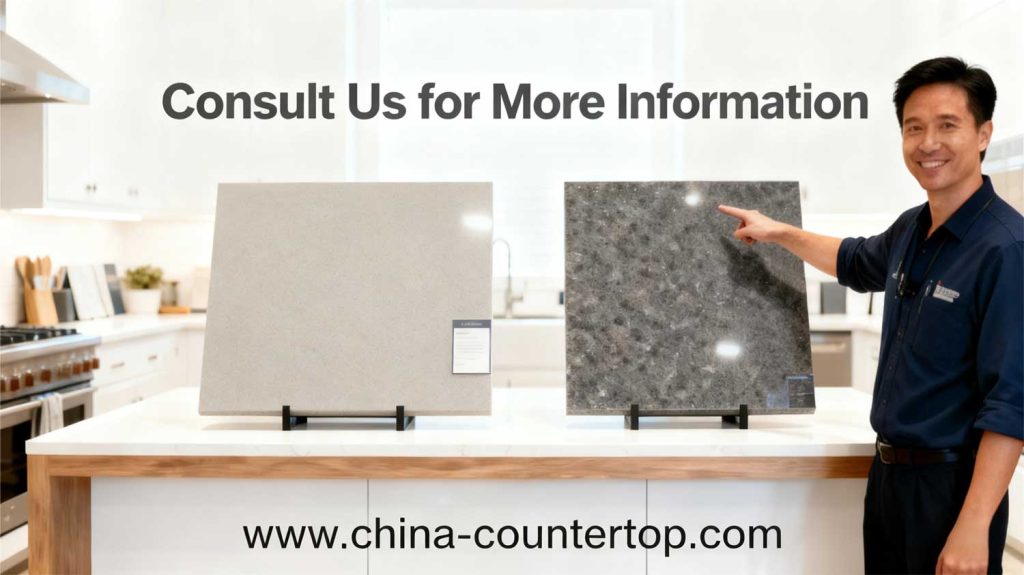
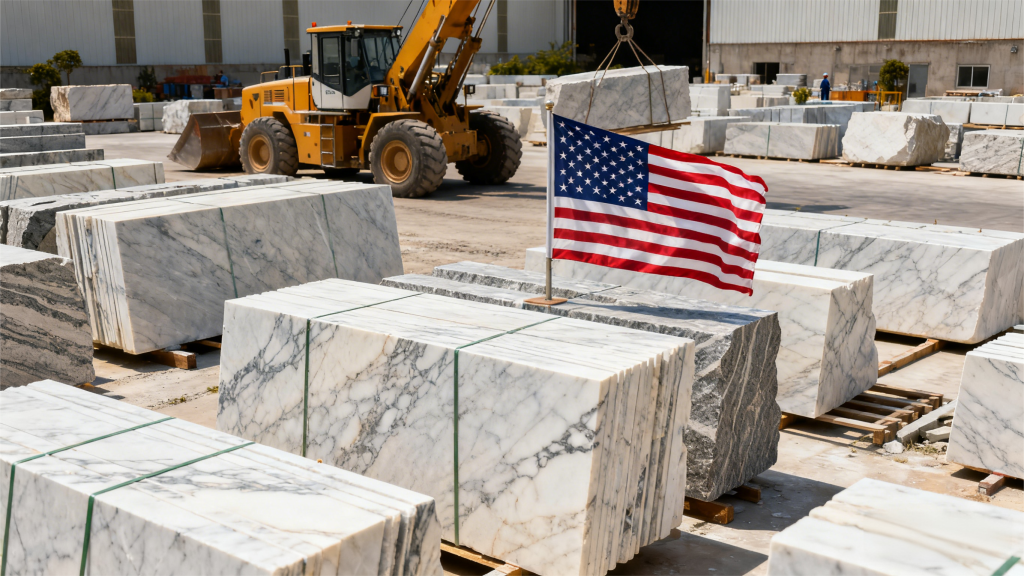

Trade War Impact on Chinese Stone Exports
The US-China trade war has fundamentally reshaped global stone industry dynamics, driving Chinese manufacturers to produce significantly higher quality engineered stone while strategically reducing exports in premium natural stone categories. This analysis examines how tariffs and market pressures have accelerated quality improvements in Chinese quartz slabs, porcelain slabs, and sintered stone, creating new value propositions for international buyers.
The US-China trade war, initiated in 2018, has fundamentally reshaped global stone industry dynamics. While initial concerns focused on declining export volumes, a more nuanced and ultimately positive trend has emerged for international buyers: Chinese manufacturers are producing significantly higher quality engineered stone while strategically reducing exports in premium natural stone categories.
Quality Over Quantity: The Strategic Pivot in Chinese Stone Exports

Faced with 25-30% tariffs and increased competition in Western markets, Chinese stone manufacturers have executed a remarkable strategic pivot from competing primarily on price to competing on quality and innovation. This transformation has resulted in measurable improvements across multiple dimensions of manufactured stone production.
Enhanced Manufacturing Processes and Technology Adoption
Chinese factories have invested over $2.5 billion in advanced manufacturing technologies since 2019, particularly for quartz surfaces and large-format porcelain slabs. These strategic investments include:
Italian Breton and German System processing systems
Adoption of European technology for precision cutting and polishing
Automated quality control with AI-powered inspection
Computer vision systems that detect imperfections invisible to the human eye
Improved resin formulations
Development of proprietary resin blends offering greater durability and stain resistance
Advanced digital printing technology
High-definition printing for more realistic veining and natural stone replication
Robotic material handling
Reduced human error and increased consistency in production
“The trade war forced Chinese manufacturers to stop competing on price alone and start investing in quality. The result is engineered stone that now rivals European products at 20-30% more competitive prices. This represents a fundamental shift in value proposition for international buyers.” – Michael Chen, Stone Industry Analyst
Material Innovation and Product Development
Beyond manufacturing improvements, Chinese companies have developed innovative material formulations that address specific market needs:
- Sintered stone with enhanced properties - Improved heat resistance (up to 400°C) and scratch resistance for commercial applications
- Large-format porcelain slabs - Production of slabs up to 3200x1600mm, reducing seams in large installations
- ECO-friendly quartz - Development of surfaces with 30-40% recycled content to meet green building standards
- Ultra-compact surfaces - 3-6mm thin panels for renovation projects and vertical applications
- Antimicrobial surfaces - Integration of silver-ion technology for healthcare and food service applications
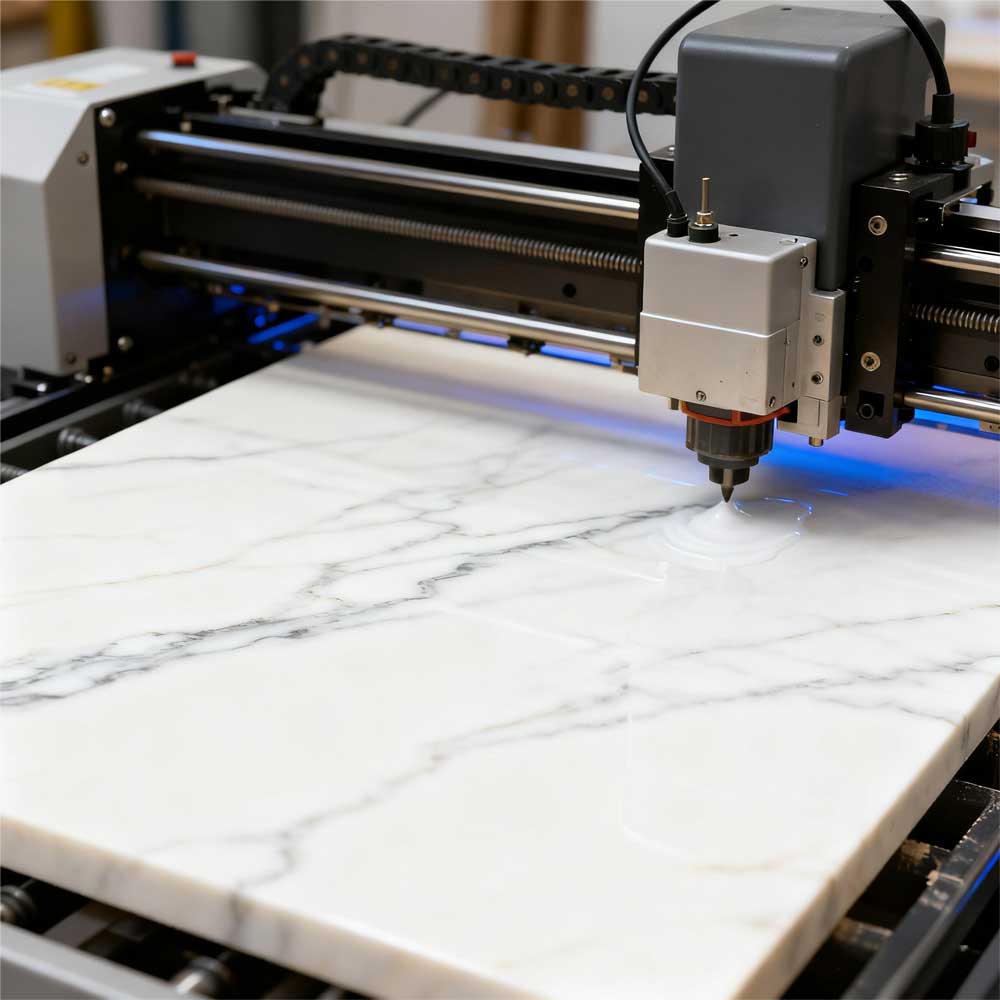
Precision engineering in modern Chinese stone company manufacturing Calacatta Quartz Slabs
Data Analysis: Export Structure Transformation
According to China Stone Association data from 2018-2023, we can clearly observe the structural transformation in China’s stone exports:
Export Volume Changes by Product Category
Regional Market Adaptation Strategies
Different international markets have responded uniquely to trade war impacts, prompting Chinese exporters to develop specialized approaches:
North American Market Transformation
The US market, once dominated by Chinese natural stone, has seen a dramatic shift toward domestic sourcing for premium marble and granite. However, this has created opportunities for Chinese manufactured stone, which offers:
| Product Category | 2018 Export Volume | 2023 Export Volume | Change (%) | Average Price Change |
|---|---|---|---|---|
| Premium Marble | 850,000 tons | 620,000 tons | -27% | +8% |
| Granite Blocks/Slabs | 1,200,000 tons | 980,000 tons | -18% | +5% |
| Quartz Slabs | 450,000 tons | 780,000 tons | +73% | -12% |
| Porcelain Slabs | 280,000 tons | 520,000 tons | +86% | -15% |
| Sintered Stone | 85,000 tons | 210,000 tons | +147% | -18% |
- Superior price-to-performance ratio compared to domestic alternatives
- Faster production lead times (4-6 weeks vs 8-12 weeks for European suppliers)
- Custom color and pattern development for specific projects
- Availability of large-format slabs reducing installation complexity
European Market Quality Focus
European buyers, while price-sensitive, have maintained strong emphasis on quality certifications and environmental standards. Chinese manufacturers have responded by:
- Obtaining CE marking, UKCA certification, and other regional standards
- Implementing ISO 14001 environmental management systems
- Developing products with Declare labels and EPDs (Environmental Product Declarations)
- Participating in international trade shows to build brand recognition
Emerging Market Expansion
Southeast Asian and Middle Eastern markets have shown growing appetite for Chinese manufactured stone, attracted by:
- Competitive pricing relative to European alternatives
- Cultural and design preference alignment
- Geographic proximity reducing shipping times and costs
- Flexible minimum order quantities suitable for smaller projects
Case Study: Fujian Stone Group's Transformation
Fujian Stone Group, one of China’s largest stone exporters, provides a compelling case study of successful adaptation to trade war conditions:
Strategic Investment Timeline
- 2019: $45M investment in Breton polishing lines and digital printing technology
- 2020: Implementation of AI quality control systems, reducing defect rate from 3.2% to 0.8%
- 2021: R&D center establishment focusing on sintered stone development
- 2022: Sustainability initiative achieving 30% reduction in water consumption and 95% material utilization
- 2023: Digital showroom launch enabling virtual material selection for international clients
Business Results
- Manufactured stone now represents 68% of export revenue (up from 32% in 2018)
- Average product price increased by 22% while maintaining competitive positioning
- Client retention rate improved from 76% to 89% despite market challenges
- New European and Australian clients offset declining North American natural stone business
Updated Sintered Stone Made Countertops to Present More Luxury Than Before
Looking for High-Quality Manufactured Stone ?
Our factory produces premium quartz surfaces, porcelain slabs, and sintered stone that meet international quality standards with competitive pricing. Contact us for samples, technical data sheets, and project-specific quotations.
Value Analysis for International Buyers
The transformation of China’s stone export industry creates compelling value propositions for different types of international buyers:
Architects and Designers
Professionals specifying materials for commercial and residential projects benefit from:
- European-quality engineered stone at 20-30% lower cost
- Custom color and pattern development for unique projects
- Comprehensive technical documentation and specification sheets
- Large-format options reducing visible seams in expansive applications
Contractors and Fabricators
Installation professionals gain advantages including:
- Consistent quality reducing waste and rework
- Reliable supply chains with predictable lead times
- Technical support for installation best practices
- Competitive pricing improving project margins
Distributors and Retailers
Businesses serving the stone market benefit from:
- Attractive price points for competitive positioning
- Branding opportunities with private label programs
- Flexible inventory arrangements and drop-shipping options
- Marketing support including photography and specification tools
Future Outlook and Strategic Recommendations
The evolution of China’s stone export industry presents both opportunities and considerations for international buyers:
Technology and Innovation Roadmap
Chinese manufacturers are expected to continue investing in:
- Further automation reducing production costs while maintaining quality
- Development of thinner, lighter panels for easier installation and reduced shipping costs
- Enhanced surface treatments for specific performance requirements
- Digital tools for visualization and project planning
Strategic Sourcing Recommendations
Based on current market dynamics, we recommend international buyers:
- Diversify sourcing - Consider Chinese manufactured stone alongside traditional options
- Verify quality directly - Request samples and, when possible, conduct factory audits
- Focus on total cost - Consider not just material cost but installation efficiency and longevity
- Build relationships - Develop direct relationships with manufacturers for better pricing and service
- Stay informed - Monitor trade policy developments that may impact pricing and availability
Conclusion
The US-China trade war has accelerated the evolution of China’s stone industry in unexpected but ultimately beneficial ways for international buyers. While high-end natural stone exports have declined, the quality and sophistication of manufactured stone have improved dramatically. Chinese manufacturers have shifted from competing primarily on price to offering genuine value through technological innovation, quality improvement, and specialized product development.
For architects, designers, contractors, and distributors, this transformation creates new opportunities to access high-performance surfacing materials at competitive price points. By understanding these market dynamics and developing strategic sourcing approaches, international buyers can leverage these changes to enhance their project outcomes and business performance.
The future of Chinese stone exports appears focused on continued innovation and quality enhancement, positioning China as a leading global supplier of engineered stone products rather than simply a source of low-cost natural stone.
By: David WU G-Stone Date: November 15, 2025
Continue Reading
- Sintered Stone vs. Quartz: Technical Comparison for Architects
- Sustainable Surface Materials: Beyond Greenwashing
- 2024 Luxury Hotel Design Trends: Material Selection Insights
Secure Your Project Budget
Contact our team for current pricing, samples, and technical specifications for your luxury hotel, residential, or commercial project.
HELPFUL RESOURCES ON CALACATTA QUARTZ COUNTERTOPS

Calacatta Quartz Countertops Technical Guide

Sourcing & Logistics Guide of Calacatta Quartz Countertops
G-Stone Calacatta Quartz Countertops' Production for Projects
Discover The Right Product for for Your Project

CALACATTA QUARTZ APPLICATIONS
ELEVATE YOUR SPACE
Cabinets manufacturers, designers, dealers and builders, time to renew your kitchen countertops collection with G-Stone Calacatta variety a more attractive product portfolio aiming at more critical customers. Choose from a range of colors and patterns to create a durable and stylish design that enhances your showroom.
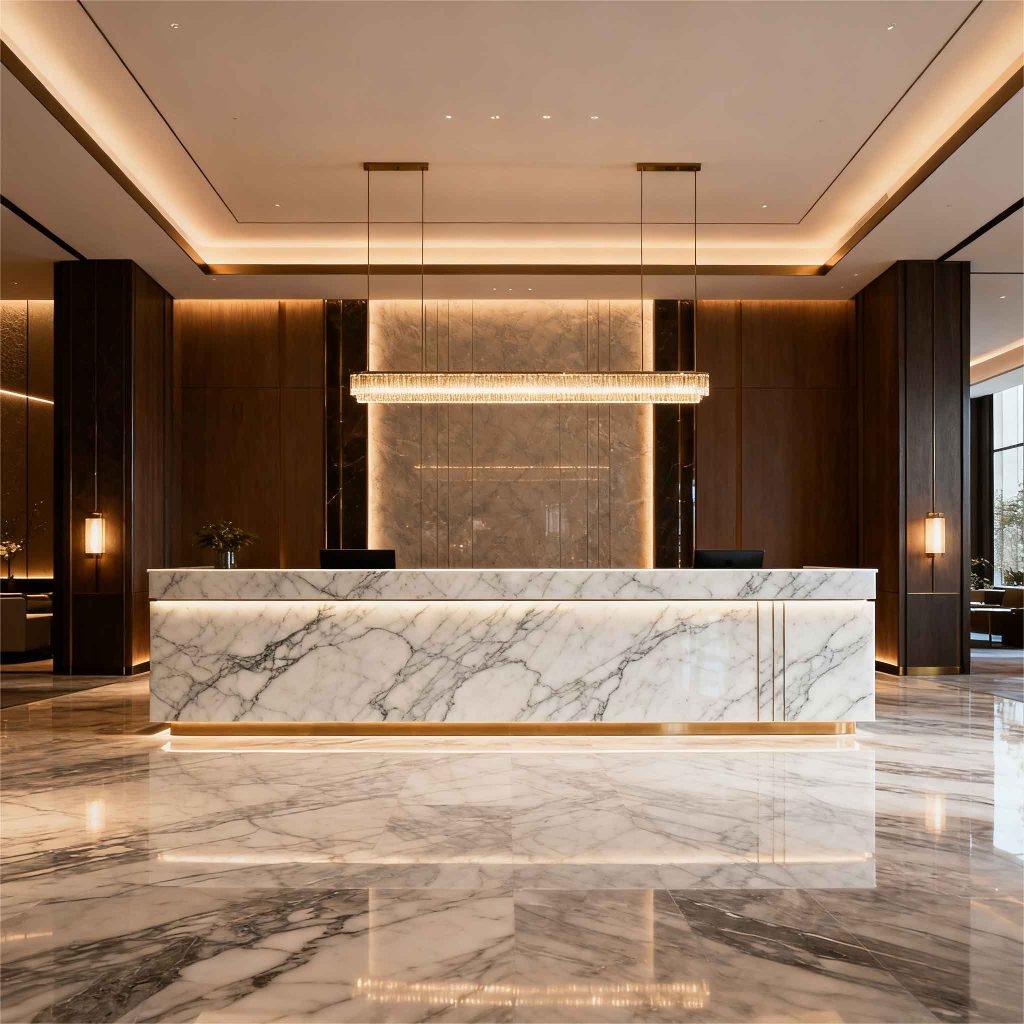
Calacatta Quartz for Hotel Projects
Hygienic & High-Traffic
Specify commercial-grade Calacatta quartz countertops for lobbies, bathrooms, and suites. Our non-porous surfaces meet strict hygiene standards and withstand heavy use, ensuring lasting beauty with minimal maintenance for your hospitality investment. View hotel case studies.
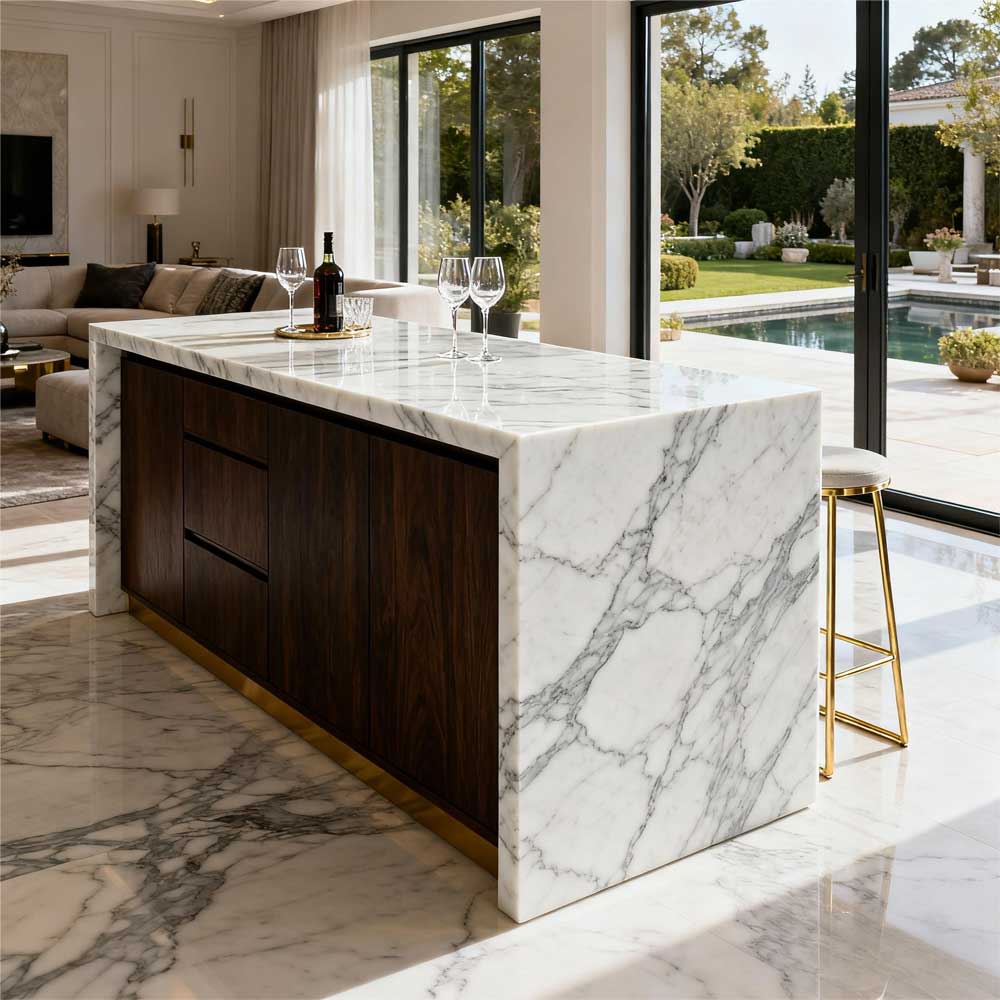
Calacatta Quartz for Luxury Villas
Grand & Customizable
Elevate luxury villa projects with large-format Calacatta quartz slabs. We enable stunning, seamless kitchen islands and statement walls that deliver the exclusive aesthetic and custom fit demanded by high-end clients. Explore villa applications.

Calacatta Quartz for Multi-Unit Projects
Consistent & Cost-Effective
Streamline your apartment or condo development with our Calacatta quartz countertops. We ensure material consistency across all units and offer bulk pricing to protect your budget while adding premium value. Inquire about volume discounts.
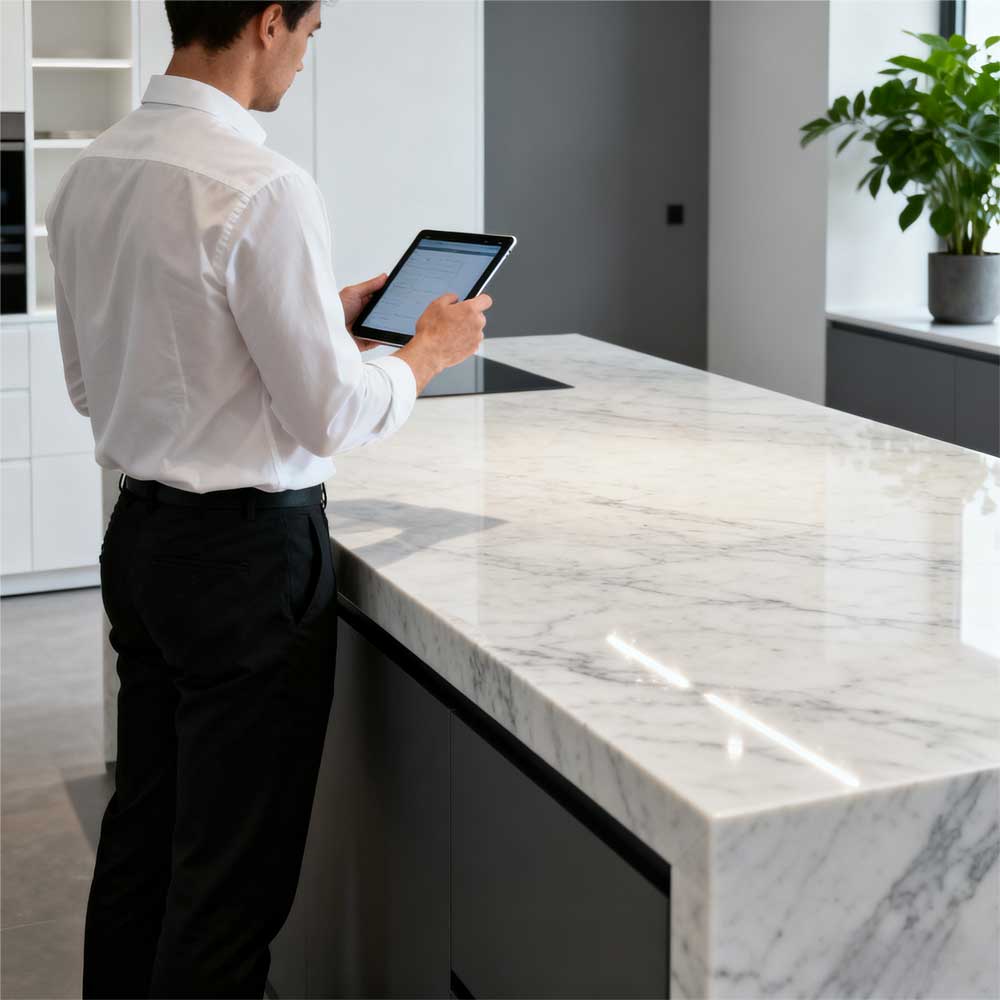
Calacatta Quartz for Designer Renovations
Precision-Cut & Flawless
Partner with us for high-end renovations. We deliver precision-fabricated Calacatta quartz countertops that guarantee a perfect fit, meeting the exacting standards of interior designers and their discerning clients. Ideal for design firms.
HELPFUL RESOURCES
Solving Project Challenges with G-Stone Calacatta Quartz Countertops
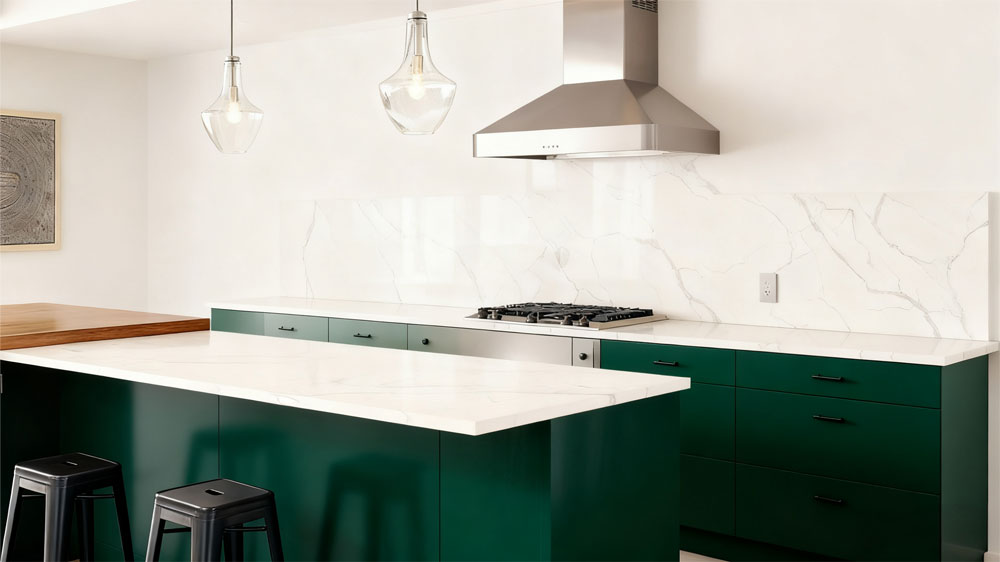
Winning Bids with Consistent Quality & Supply
As a distributor, have you ever lost a lucrative project due to inconsistent slab quality or unreliable supply? Material variations and delays can damage your reputation and derail your clients' timelines, putting your hard-won bids at risk.
G-Stone is your reliable partner. We prioritize consistent veining and color across our Calacatta quartz collections, ensuring the sample you show is the product you deliver. Our robust inventory and efficient logistics guarantee on-time slab supply, allowing you to promise and meet deadlines with confidence. Partner with us to enhance your credibility and secure more projects.
Streamlining Installation & Minimizing On-Site Risks
For contractors and fabricators, unpredictable materials are a nightmare. Are you facing issues with fragile slabs leading to breakage, or inconsistent dimensions causing costly installation delays and material waste? These on-site surprises eat into your profits and compromise project schedules.
Our engineered Calacatta quartz is manufactured for superior strength and dimensional accuracy. This means fewer breakages during handling and precision cuts that fit perfectly the first time. By reducing fabrication errors and on-site adjustments, we help you adhere to timelines and protect your profit margins. Let us bring predictability to your execution.
Delivering Lasting Aesthetics & Investment Value
As a developer or property owner, you seek materials that offer both immediate visual impact and long-term durability. Will the chosen surface stain easily, requiring frequent maintenance? Will it lose its luster in a few years, diminishing your property's premium appeal and value?
G-Stone's Calacatta quartz provides a permanent solution. Its non-porous surface resists stains, scratches, and bacteria, eliminating the need for high-maintenance sealing. It retains its like-new appearance for decades, even in high-traffic areas. This translates to lower lifetime costs, enduring beauty, and enhanced property value—making it a smart, future-proof investment for any prestigious project.
G-STONE PREMIUM NATURAL QUARTZ FAQS
How can I be confident in your supply of Calacatta Quartz Countertops for my project?
Confidence in your Calacatta quartz countertops supplier is crucial. We prove our reliability not just with words, but with evidence. We invite you to verify the quality yourself through three key steps tailored for project success. First, request physical samples of our Calacatta quartz to assess the material firsthand. Second, schedule a video or in-person tour to inspect our slab inventory and consistent quality. Finally, consult directly with our project specialists to discuss your specific needs for countertops and receive a tailored proposal. Take the next step: Contact us today to request your sample kit and start a partnership built on proven quality.
Why is Calacatta quartz a better choice for projects than marble or granite?
Calacatta quartz offers the premium look of marble without its high maintenance. Unlike porous marble and granite, it is non-porous, making it highly resistant to staining, scratching, and bacteria—no sealing required. This translates to lower long-term costs and greater durability for high-traffic commercial and residential projects, ensuring your investment is protected.
Is Calacatta quartz suitable for high-traffic commercial projects like hotels?
Absolutely. Our commercial-grade Calacatta quartz countertops are specifically engineered for high-traffic environments. They excel in hotels, restaurants, and lobbies due to exceptional durability, ease of maintenance, and consistent supply—all crucial for meeting strict project timelines and maintaining stringent hygiene standards.
Do you offer jumbo slabs for a seamless look in large projects?
Yes, we specialize in supplying jumbo slabs of Calacatta quartz. These large-format slabs are ideal for expansive kitchen islands, conference rooms, and feature walls, significantly minimizing visible seams. This creates the breathtaking, continuous visual flow that is essential for luxury villa and high-end commercial designs.
What is your process for ensuring consistency in large-scale projects?
For multi-unit projects, we implement a batch-reservation process. We carefully select and reserve sequential slabs from the same production run to guarantee color and veining consistency across all your units. This proven sourcing and logistics process eliminates variation risks, ensuring a uniform, premium finish for your entire development.
What is Calacatta Quartz ?
Calacatta Quartz is a premium engineered stone that replicates the look of the ultra-luxurious, rare Calacatta marble. It's famous for its dramatic, bold veining on a bright white or off-white background, creating a striking and elegant aesthetic.
What color is quartz calacatta slab of G-stone?
G-STONE manufacture varous colors of calacatta and Engineered Quartz Countertops: Made from crushed natural quartz and resin, it can be any color imaginable. The most popular are brilliant whites, charcoal grays, and designs that mimic stone like marble (with veining) and granite.you can check the product section of our website.
what is the best countertop material? Is the calacatta ?
There is no single “best” countertop material for everyone. The ideal choice depends on your budget, style, and how you use your kitchen. The cdalacatta design is the most popular marble look quartz applicaiton, especially in the applicaion of commercial spaces.
How big is a slab of quartz calacatta?
The calacatta quartz slab is made maximum to 3200*1600mm, so that it can make product up to 1.6M in width in G-Stone. Parnters are also able to custome the size according to their actual project.
What is the best countertop? Is it calacatta ?
"What is the best countertop?" doesn't have a one-size-fits-all answer, as the best choice depends on your needs. However, when people ask this, they are often dreaming of the luxurious look of Calacatta. Calacatta is a STYLE, not a MATERIAL. It refers to the iconic look of rare Italian marble known for its bright white background and bold, dramatic gray veining. The "Best" Material for a Calacatta Look: For most kitchens, the best way to get the Calacatta style is with Calacatta Quartz. It gives you that stunning high-end design, but with the superior durability, stain resistance, and low maintenance of quartz—making it a truly "best of both worlds" choice. So, is Calacatta the best? For unmatched elegance, yes. And for a practical and beautiful daily surface, Calacatta Quartz is the top contender.
Where to Buy Quartz Countertops Near Me?
We are a leading quartz slab manufacturer, so we supply our products to professional distributors and fabricators worldwide, not directly to homeowners. The best way to find our quartz for your project is to contact local countertop fabricators or kitchen showrooms in your area. These professionals purchase our slabs and expertly fabricate them into custom countertops. When you speak with them, simply ask: "Do you source your quartz from [Your Company Name]?" Browse Our Collections to see our colors and patterns first. Request a Sample through us or your local fabricator to see the quality in person. Are you a business looking to partner with us? If you are a distributor, fabricator, or project manager, we invite you to contact our sales team for wholesale pricing and partnership information.
Where to buy cheap quartz countertops?
If you are distributors or businesman, why not contact us to check if we can make the countertops by stocked slabs, usually they are much cheaper.


